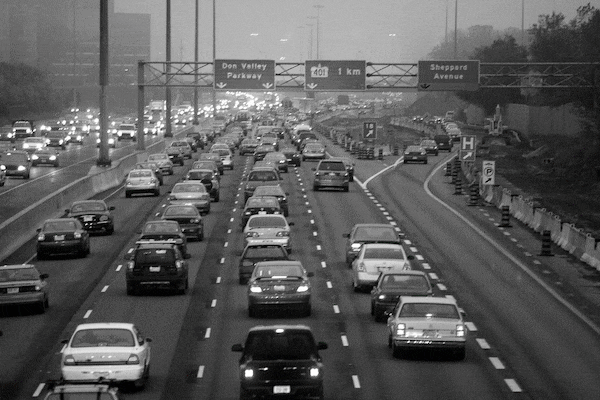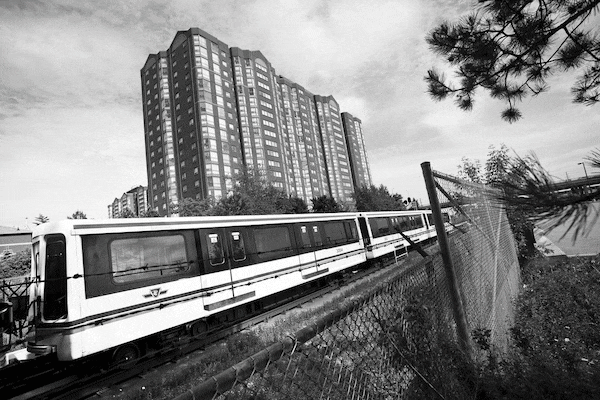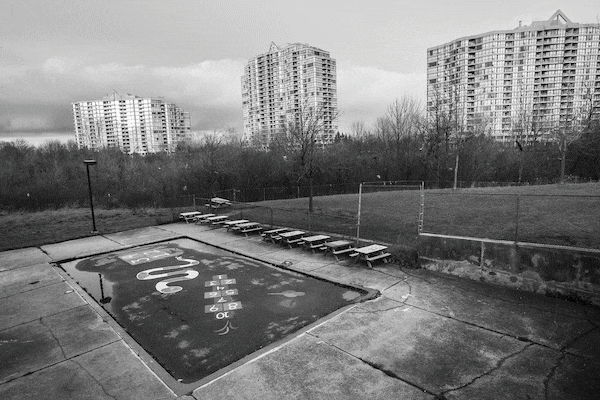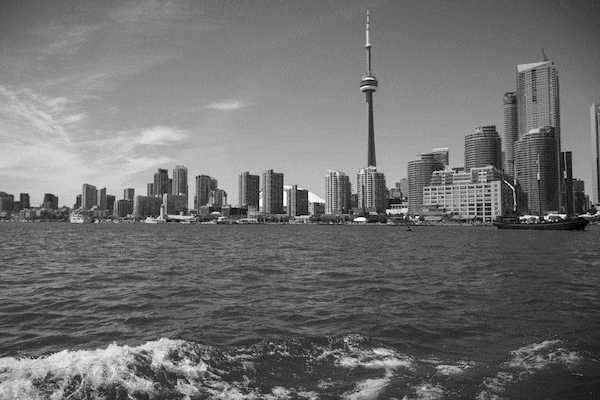
Downtown Toronto, as seen from Cliff Lumsdon Park in Etobicoke's Lakeshore Village. The Globe's Denise Balkissoon talked with LGBTQ youth groups in Etobicoke, North York and Scarborough to learn about the challenges of growing up queer in Toronto's suburbs.Photo illustration (picture: Jennifer Roberts/The Globe and Mail)
Denise Balkissoon is a Globe and Mail columnist.
My son has beautiful hair. Yes, I’m biased, but it’s true – just the other week, a stranger stopped us on the street to comment on his locks, which are varied shades of golden brown with flecks of deep chocolate and bright blond.
He’s absorbed the compliments and resists getting it cut. His hair is always at least down to his ears and sometimes brushes his shoulders. I tell myself that my constant urge to trim it is because I’m sick of the knots, but I know that it’s also because people regularly mistake him for a girl.
My goal has always been to present him with options for who and how he could be in the world, then let him figure out what works for him. He’s now 4½, and has no lack of opinions. But I still feel a tug of fear when he chooses something not seen as masculine, as though I’ve put him up to taking an unnecessary risk, and a guilty relief when he makes traditionally gendered demands, such as for a wardrobe adorned with images of dump trucks. At the root is my desire that no one be mean to him, ever.
The gap between the parent I want to be and the parent I actually am surfaced in my thoughts last spring, as I visited LGBTQ youth groups that meet in Toronto’s suburbs. I thought I’d hear about long commutes and meet kids of varying racial and ethnic backgrounds, and hear about their experiences reconciling their various identities. Those assumptions were true, but also more complicated than I imagined.
In chatting with teens, young adults and group facilitators in Etobicoke, North York and Scarborough, I heard few complaints about the TTC and much more angst about generational differences. Some of these clashes were with parents who were newcomers to Canada, but not all: White teens were also often emotional about the difficulties they were having finding parental acceptance.
What youth of all ethnicities had in common was the ability to discuss these differences with thoughtfulness and compassion, despite their vulnerabilities. Their willingness to take risks reinforced my need to be an adult – to not let awkwardness, or even fear, get in the way of helping the young people in my life become the best, healthiest version of themselves.
One such person was Kyle, who attends Compass, a drop-in group for youth with intellectual disabilities who identify as transgender, two-spirited or queer. It’s held at the Griffin Centre, a mental-health agency in a single-storey North York mall, next to a hydro field.
Every Thursday afternoon, 12 or so youth hang out and cook dinner in a bright kitchen. The day I’m there, the group includes Kyle, a short, brown-skinned transgender man with glasses and a blond streak in his hair who speaks with a Trinidadian accent.
It’s not immediately obvious, in part because the 23-year-old has lived in Canada for decades and in part because he has cerebral palsy and stutters a bit when he talks. But I could tell that Kyle was from the same country as my parents thanks to phrases such as “oh gosh,” “to be honest with you,” and “woooooow” with a long, drawn-out O.
“Woooooow,” is what Kyle said when I told him that Trinidad and Tobago is finally making progress on LGBTQ rights. He hadn’t heard that, this past April, the Caribbean country’s highest court had ruled its existing “buggery” laws unconstitutional and was moving towards decriminalizing homosexuality.
“That is so great,” said Kyle, who added some of his family members are more willing to accept his gender identity than others. “My dad don’t understand a lot. But you know, my mom is teaching him. It’s a learning curve, and everybody tries their best.”
This generosity and patience was humbling, especially because Kyle lives in a group home, and is dependent on a support worker for rides to the drop-in, the one place he feels fully himself.
“I would never switch back to my old gender now. I love being a boy,” Kyle said. “I noticed that since I came to Compass, I have been feeling, like, a lot happier.”

Traffic during rush hour on Highway 404 in North York.Photo illustration (picture: Randy Quan/The Globe and Mail)
The fragility of that happiness is in stark relief now in Ontario, which has a new government that’s been openly hostile to LGBTQ people. Premier Doug Ford refused to attend Toronto’s Pride parade, unsurprising since he campaigned on “repealing” a three-year-old sexual education curriculum that includes basic information about online safety and consent, but which he claimed taught “six different genders and all the nonsense.”
The state of that curriculum is now unknown – Education Minister Lisa Thompson announced in early July that teachers would be using a 20-year-old lesson plan this September, then appeared to soften that position, followed by Mr. Ford insisting the 1998 curriculum would be back in the classroom next school year. As adults argue over where to draw the lines between public education and parental rights, it’s hard to hear the voices of youth who actually attend Ontario’s public schools.
“I feel very hurt by the way that it’s presented, as though learning about gender identities, learning about queer issues, is considered inappropriate for children,” said Paisley, a 17-year-old who attends Toby’s Place, a Monday night drop-in southwest Scarborough. “I think that if I, when I was a child, I had had that kind of education, I think it would have been so much easier for me.”
All of the kids I spoke with at Toby’s Place said their parents knew they were there. The group was mostly white, and seemed solidly middle-class. Most were students at specialized high schools with arts and sports streams, where they had access to gender-neutral bathrooms and/or Gay Straight Alliance clubs (which, as of last June, Alberta high schools must ensure their students have access to).
But the difference between how they presented themselves to their parents and how they saw themselves often still chafed. Paisley, who uses the pronoun they, came out to their parents as a lesbian, but actually identifies as transgender and bisexual. They haven’t told their parents that they regularly wear a chest-binder to have a more masculine upper body shape, or that they want to medically transition as soon as possible.
That’s made more difficult by the fact that Paisley will continue to live at home even after they start university in the fall. “As long as I’m in my house, I’m a girl and when I’m outside of my house, I get to be me,” said Paisley, who was energetic and full of humour, and went to prom with their girlfriend, who is also transgender.
A number of teens I spoke to seemed to be halfway out: Three or four had told their parents that they were gay when they really considered themselves transgender, or preferred a more fluid, less commonly used term, such as non-binary or pansexual. These are honest and brave ways for young people to consider their emerging selves. To be fair, I can also sympathize with parents who aren’t used to considering identity in such amorphous terms. One teen shrugged nonchalantly when I asked what pronoun she prefers. “It changes so frequently,” she said, which isn’t particularly helpful to a journalist.
“They think I’m just gay," said Eileen, a 17-year-old who attends the weekly You Belong drop-in at Fairview Library, which is about a 40-minute public-transit journey from her home in East York. “I haven’t told them that I’m not.”
Eileen considers herself queer and bisexual, but said “lesbian” was easier for her parents to understand. Eileen’s parents were supportive when she came out. They know she’s a regular at the group and that she’d worked with a teacher to make her Grade 9 sex-ed curriculum more LGBTQ-inclusive. In fact, her parents are good friends with a female couple, which in a way was part of the problem.
“They still think you’re going to have, like, the exact same life – you’re going to get married, you’re going to have kids,” she said of their expectations of her future. “You’re like the same thing, just with a woman, not a man.”

A Scarborough Rapid Transit train drives near Kennedy station.photo illustration (picture: Kevin van Paassen/The Globe and Mail)
Wallace Wong, a psychologist in child and youth sexual health in B.C.’s Ministry of Children and Family Development, says a deep desire for children to be safe is a significant reason parents push their queer kids towards marriage and nuclear families.
“Having the law protecting them, normalizing this population, also helps the parent have less fear for the future of the kid,” said Dr. Wong.
Over the past 20 years, he’s seen his private-practice client base shift from mostly gay and lesbian to overwhelmingly gender non-conforming. “It’s definitely a little easier for the parents” to imagine a secure future for gay or lesbian children than those with less commonly recognized identities, he said.
In June, 2017, the federal government passed Bill C-16, adding gender identity and gender expression to the list of prohibited grounds of discrimination in the Canadian Human Rights Act. But the preceding discussion revealed significant animosity toward transgender people. It emboldened University of Toronto professor Jordan Peterson to reject his students’ requested pronouns, and coincided with clashes over addressing gender orientation in British Columbia’s anti-bullying programs.
Legal protections for transgender Canadians are newer, and more fragile, than same sex marriage, and parental acceptance is often more fragile, too. Staff at all of the groups told me about parents forbidding their children from attending. That includes at RexPride, held at the Rexdale Community Health Centre in Etobicoke. It was started six years ago by Terrence Rodriguez, a transgender man who was working as a counsellor there already, and kept being asked to mentor individual LGBTQ youth.
“I was like, alright, let me create something,” he said.
None of the eight or so current regulars at his Tuesday drop-in identifies as white, Mr. Rodriguez said – one is Indigenous and the rest are immigrants or children of immigrants, from places including the Middle East, South Asia and Africa. One is a 17-year-old refugee from Trinidad in Canada alone.
And, he said, “Out of all of the youth in my program, I think one has a parent that supports them.” Most of the time, RexPride participants stop talking to their parents as soon as they’re able to move out on their own.
It’s discouraging, but Mr. Rodriguez said he understands that many newcomers experience persecution in their home countries, and just want their kids to keep their heads down here. In trying to build bridges, he doesn’t get hung up when people use language some might consider politically incorrect. “I have to be flexible in where they’re at and not get defensive, because that just defeats the outcome I’m trying to achieve,” he said.
At Toby’s Place, a biracial 17-year-old named Sky-Ravinn felt the same about her Jamaican grandmother, who raised her. “She uses the phrase ‘batty man,’ I’m not going to lie,” said Sky-Ravinn. What’s more important is that her grandmother is “cool” with her being pansexual, an umbrella term for those attracted to a wide range of genders and sexualities.

In Rexdale, buildings loom behind an old swimming pool converted into a playground.photo illustration (picture: Jennifer Roberts/The Globe and Mail)
Discussing homo- and transphobia in racialized communities is sensitive, and complicated. Common assumptions that non-white parents are prejudiced while white parents aren’t is simplistic at best: A white youth almost cried telling me that his mom replied to his coming out as non-binary with “So, you want a penis?" Sky-Ravinn said her white grandparents told her it was fine to volunteer at LGBTQ events as long as she wasn’t LGBTQ herself.
Meanwhile, at You Belong, a Filipina teenager was surprised that her Christian parents were so supportive when she came out as bi-curious. “I thought they’d be the kind of parents that slap you with the Bible or something,” she said. “But they said, like, 'We can’t judge you, only God can do that.’”
The ability to honestly discuss these layered identities is one draw of RexPride. “It’s not just ‘I’m queer,’ I’m also a newcomer, I’m also from that cultural background or this religious background,” Mr. Rodriguez said. “It’s a relief to find other people who have those intersectionalities as well.” South Asian youth have told him their parents are more understanding of transgender identities than homosexuality, since certain Hindu communities have always made space for a third gender. That’s a particular nuance that leaders or participants in more mainstream LGBTQ groups might not understand.
There are many reasons non-white parents might be challenged by their children’s LGBTQ identity, Dr. Wong said. Being a sexual minority in their home country might be “severely frowned upon, or a death sentence": Their first instinct is probably to seek advice from local friends or leaders, who might reinforce any existing bias they already have.
Many want to fit into Canadian life but still fear losing their own cultures or their communities. This struggle is reinforced when immigrants are scapegoated as naturally homophobic and resistant.
“When people say, ‘If you don’t like it, why don’t you go back to China?’ that makes them feel more powerless,” he said. And even parents who are willing to seek outside information might have trouble finding it in their first language. These are just some of the reasons racialized parents are reluctant to bring their children to see Dr. Wong, and that those who do reach out have often avoided the issue until their child is in mental-health crisis, even suicidal.
But he has been able to make inroads. Chinese communities in Vancouver have thawed toward him, especially because he speaks both Mandarin and Cantonese. “They like when I tell them about my early years in Hong Kong,” he said, “and that I’m still living with my parents.”
Parents become increasingly open, he said, after a comprehensive assessment by him and his team. They’re relieved to have culturally appropriate help to understand where their children fit on a spectrum of gender and sexuality, and a plan to work toward mental well-being.
“They are so afraid: ‘Am I supporting something that may not be true? Am I supporting my kid down the so-called wrong path?'” he said. “So once they know the professionals did their due diligence, they feel more comfortable. ‘Okay, this is not something they chose to be just because of the internet, actually it’s a real thing. Now I need to jump on board and be able to set sail with my kid on this journey.’”
Not all parents will come around, which is why it’s important for adults who do care that kids have access to honest, helpful information about gender and sexuality help make it happen. But grown-ups sometimes grow up too. Paisley, for example, told me that their parents were opposed to her attending Pride, which was the case with my mom, too.
While I’ve always known I was more or less straight (how’s that for a solid identity?), I’ve also always been a fan of human rights and good parties. So, sometime in the early 1990s, a high-school friend and I took the subway downtown from Scarborough to see our first Pride parade. My mom figured out where we had gone and yelled at me when I got home, although her specific objections were vague.
She never brought it up again, and in the decades since, she’s been entirely supportive of LGBTQ family members both in and out of the closet. A year or two ago, I asked her what the big deal had been and she didn’t even remember the argument. Today, she says, “I’ve learned not to mouth off about things if I haven’t had that experience. See how wise I’ve become?”
The overarching lesson, I think, is that while Heather Has Two Mommies and The Boy and the Bindi are both awesome books, they can’t ensure my parenthood path is smooth, because that’s impossible. The teens I met didn’t expect to be fully protected from experiencing cruelty or judgement. What they wanted was for their families to make a real effort to understand them. Being a good parent is about making sure my son has the confidence to walk his path alone, while being there to grab his hand when the terrain gets rocky. That, and brushing the tangles out of his hair with as little tugging as possible.

Photo illustration (picture: Tijana Martin/The Canadian Press)